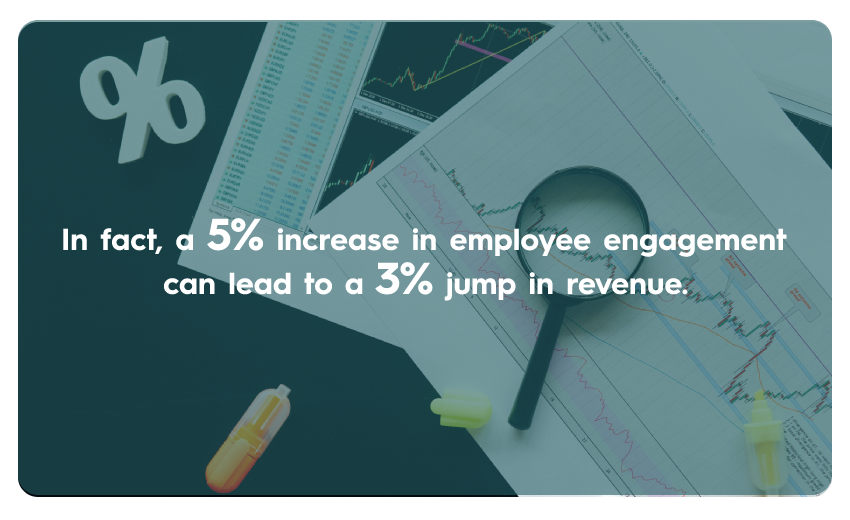
10 Employee Engagement Statistics You Need to Know in 2024
Did you know that employee engagement is key to company success? But what does employee engagement actually mean? And how can you make sure your team is engaged? Get a quick brief about what employee engagement is, and check out these ten employee engagement statistics to learn more.
What is Employee Engagement?
Employee engagement is the extent of sincere effort made by the employees in investing their emotional, behavioural, and cognitive abilities for the growth of their organization.
The following behaviours display the measure of Employee Engagement:
- Degree of enthusiasm employees shows at work
- Consistency in updating themselves to improve their output
- Depth of meaning and purpose employees find at work
- Degree to which employees help others in their team with the organizational goals
- Enthusiasm for coming up with good ideas for organizational growth.
Employee Engagement Statistics
How engaged are employees at work?
It’s a question that HR professionals and business leaders frequently ask. After all, employee engagement is linked to higher productivity, lower turnover, and many other positive outcomes. But coming up with an answer can be tricky since there are many different ways to measure engagement.

Here are a few employee engagement statistics that can help give you a better understanding of the current state of affairs:
1. The Percentage of workers who are engaged at work is only 36%
Employee engagement is a hot topic these days. With the Percentage of engaged workers only 36%, it’s no wonder businesses are looking for ways to increase engagement.
There are several theories about what leads to engagement, but one of the most popular is the idea of “flow.” It is the state of being completely absorbed in an activity to the point where time seems to disappear.

So how can businesses create an environment that promotes flow? One way is to provide employees with opportunities to learn new skills and grow in their careers. Another is to encourage collaboration and reward creativity. By fostering a culture of engagement, businesses can create an environment where workers are more likely to be productive and satisfied.
2. Employees who are highly engaged produce a 23% increase in profitability
A 23% increase in profitability may seem like little. Still, when you consider that engaged employees are also less likely to leave their jobs, the impact of employee engagement becomes even clearer.
Implementing a 1-3-5 rule can make the employees engaged with a high rate of productivity too. Applying this rule can give the right flow task execution which will keep the employee engaged all the time with profitable tasks.
In addition to reducing turnover, engaged employees are more productive and more likely to create a positive work environment. As a result, investing in employee engagement is a smart business move that can pay off in both the short and long run.
3. Employee Disengagement Increases the Chance of Daily Stress by 48%.
A study found that disengaged employees have a 48% higher likelihood of daily stress than those engaged in their work. Companies should promote tools and methods for employee engagement to create a more positive work environment and improve employees’ well-being. .
4. Only 25% of leaders actually have an engagement strategy, despite the fact that 90% of leaders believe it has an impact on business success.
Employee engagement is critical to business success, yet only a quarter of leaders have a strategy in place. This stat comes from a recent study, which found that 90% of leaders believe an engagement strategy has an impact on business success.
So why the disconnect?
It could be that many leaders don’t know where to start when it comes to developing an engagement strategy. Or it could be that they’re not aware of the benefits of engagement. Employee engagement isn’t just about making workers happy – although that’s certainly a part of it.
Engaged employees are more productive, more engaged with their work, and more likely to stick around. So if you’re one of the 75% of leaders without an engagement strategy, now is the time to develop one. Your business will thank you for it.
5. Employers use technology to track engagement in 16% of cases.
Employers are always looking for ways to measure and improve employee engagement. Over the past few years, there’s been a growing trend toward using technology to track engagement. This can take many forms, from simple surveys to more sophisticated tools and time tracking software that track employee behaviour & productivity.
Want to try our Time Tracking Software?
Try Desklog for free!

The advantages of using technology to track engagement are clear. It can provide real-time data that an organisation can use to identify and address problems quickly. Further, it can also be more cost-effective than traditional methods like surveys.
6. Companies with highly engaged employees experience a 20% increase in sales.
Employee engagement has been shown to have a positive effect on a company’s bottom line. Companies with highly engaged workers report 20% higher sales, and engaged employees are also less likely to leave their job. There are a number of ways to increase employee engagement, but some of the most effective methods include providing opportunities for professional development, offering flexible work hours, and creating a culture of transparency and open communication. By taking steps to engage their workforce, companies can boost morale, improve retention, and ultimately increase their bottom line.
7. Revenue can grow by 3% for every 5% increase in employee engagement.
Studies have shown that there is a strong correlation between employee engagement and productivity.

That’s why more and more companies are focused on finding ways to keep their employees happy and engaged.
8. Businesses with engaged workforces experience up to a 41% reduction in employee absenteeism.
Engaged employees are more productive, more efficient, and more likely to stick around, which saves the company money in the long run.
Perhaps most importantly, businesses with engaged workforces have lower employee absenteeism rates by up to 41%. That means less lost productivity and fewer disruptions in the workplace.
When employees feel like they’re part of a team and that their work is meaningful, they’re more likely to show up and do their best work. So if your business wants to reduce absenteeism, start by promoting employee engagement. The benefits will be clear in no time.
9. Customer ratings go up by 10% with increased employee engagement.
For good reason – engaged employees lead to better customer ratings. In fact, an increase in employee engagement leads to a 10% increase in customer ratings.

That might not seem like much, but it can have a big impact on your business. Employee engagement leads to better performance, higher quality work, and improved morale. And all of that leads to better customer service. Engaged employees are more likely to go above and beyond for your customers. So if you’re looking for ways to improve your customer service, increasing employee engagement should be at the top of your list.
10. Team managers and leaders are in charge of 70% of the changes in team engagement, according to employee engagement data.

The good news is that there are plenty of ways to improve employee engagement. From providing adequate training and development opportunities to setting clear expectations and giving employees a voice, there are many things that managers and leaders can do to foster a more engaged workforce. With employee engagement being so crucial, it’s important for managers and leaders to take an active role in promoting it within their teams.
Conclusion
Employee engagement is important because it can impact an employee’s productivity, job satisfaction, and even physical health. Stressed and unhappy employees are less likely to be productive and may even experience health problems. In order to keep your employees happy and engaged, you need to stay up-to-date on the latest employee engagement statistics. The good news is that we’ve got you covered with all the important statistics.


Awesome post, thanks for sharing.